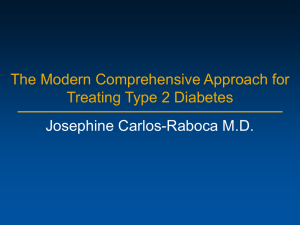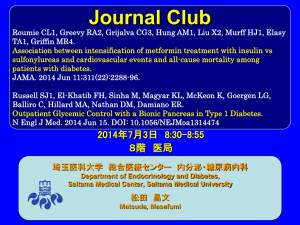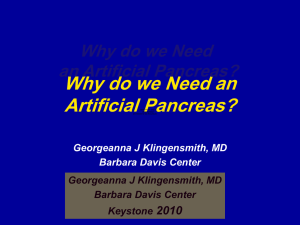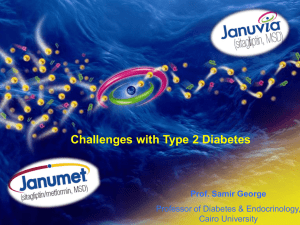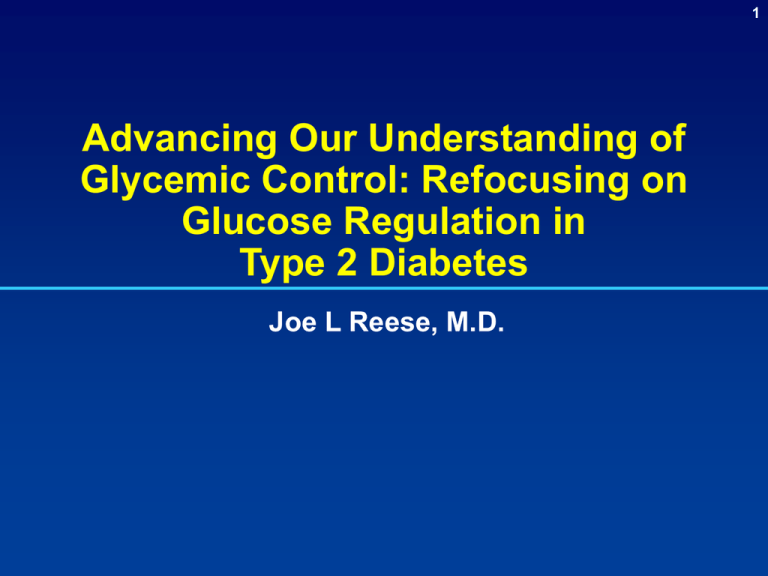
1
Advancing Our Understanding of
Glycemic Control: Refocusing on
Glucose Regulation in
Type 2 Diabetes
Joe L Reese, M.D.
2
Learning Objectives
• Describe the multiple factors involved in the
pathogenesis of type 2 diabetes and explain their
contribution over time.
• Explain the role of incretin hormones in
maintaining normal glucose homeostasis.
• Discuss clinical challenges and guideline
recommendations for getting patients to
goal.
• Describe the efficacy, safety/tolerability profile,
and place in therapy for sitagliptin in patients
with type 2 diabetes.
3
Type 2 Diabetes:
Refocusing Priorities
Diabetes: a multifactorial disease
Impairment of insulin
secretion coupled with
unsuppressed glucagon
release
Impairment of
insulin action
(ie, insulin resistance)
Pancreatic islet- (alpha- and beta-)
cell dysfunction:
a central factor in the development
of hyperglycemia and progression of type 2 diabetes
Progressively reduced insulin
secretion from
beta cells, contributing to
hepatic glucose overproduction
1. Del Prato S et al. Horm Metab Res. 2004;36:775–781.
2. Porte D et al. Clin Invest Med. 1995;18:247–254.
Major defect in insulin resistance
already present at onset of diabetes
Excess glucagon release
from alpha cells, leading to
hepatic glucose overproduction
4
Manifestations of Beta-Cell Dysfunction in
Type 2 Diabetes Mellitus
Increased proinsulin
to insulin ratio1
Abnormal pulsatile
insulin response1
Beta-Cell
Dysfunction
Decreased beta-cell
responsiveness
to glucose2,3
1. Buchanan TA. Clin Ther. 2003;25:B32–-B46.
2. Buse JB et al. Williams Textbook of Endocrinology. 2003:1427–1483.
3. Ward WK et al. J Clin Invest. 1984;76:1318–1328.
4. Marchetti P et al. J Clin Endocrinol Metab. 2004;89:5535–5541.
Decreased insulin
production4
• Decreased
insulin content
• Decreased
insulin granule
density
5
Over a 10-year Study, Beta-Cell Function Worsened
and Insulin Resistance
Remained Relatively Constant
Belfast Diet Study
Beta-Cell Function
80
Insulin Sensitivity
60
HOMA % S
HOMA % β
60
40
40
20
20
0
0
0
2
4
6
0
2
4
6
Years From Diagnosis
N=432
%β=measure of beta-cell function; %S=measure of insulin sensitivity.
Levy J et al. Diabet Med. 1998;15:290–296. Permission requested.
6
Alpha-Cell Dysfunction Contributes to
Excess Hepatic Glucose Production
Alpha-Cell Dysfunction
Dysregulation of
glucagon secretion
during fasting
Impaired suppression of
glucagon secretion
after a meal
Fasting and postprandial hyperglycemia in type 2 diabetes
1. Del Prato S et al. Horm Metab Res. 2004;36:775–781.
2. Clark A et al. Diabetes Res. 1988;9:151–159.
3. Butler PC et al. Diabetes. 1991;40:73–81.
7
Fasting and Postprandial Hepatic Glucose
Output in Type 2 Diabetes
Meal
Endogenous Glucose
Production, µmol/min/kg
20
Subjects Without
Diabetes (n=12)
18
Subjects With
Diabetes (n=18)
16
14
12
10
8
6
4
2
–30
0
30
60
90
120 150 180 210 240 270 300
Time, min
Kelley D et al. Metabolism. 1994;43:1549–1557. Permission requested.
8
Glucoregulatory Role of
Key Incretin Hormones
GLP-1
GIP
Is released from L cells in ileum and
colon1,2
Is released from K cells in
duodenum1,2
Stimulates insulin response from
beta cells in a glucose-dependent
manner1
Stimulates insulin response from
beta cells in a glucose-dependent
manner1
Inhibits glucagon secretion from
alpha cells in a glucose-dependent
manner1
Does not affect gastric emptying2
Inhibits gastric emptying1,2
Reduces food intake and
body weight2
GLP-1=glucagon-like peptide-1; GIP=glucose-dependent insulinotropic peptide.
1. Meier JJ et al. Best Pract Res Clin Endocrinol Metab. 2004;18:587–606.
2. Drucker DJ. Diabetes Care. 2003;26:2929–2940.
Has no significant effects on satiety
or body weight2
9
The Incretin Effect Is Diminished in
Subjects With Type 2 Diabetes
Control Subjects
(n=8)
Normal Incretin Effect
80
IR Insulin, mU/L
IR Insulin, mU/L
80
Subjects With Type 2 Diabetes
(n=14)
60
40
20
0
Diminished Incretin Effect
60
40
20
0
0
60
120
180
Time, min
Oral glucose load
IR=immunoreactive.
Nauck M et al. Diabetologia 1986;29:46–52. Permission requested.
0
60
120
Time, min
Intravenous (IV) glucose infusion
180
10
GLP-1 and GIP Are Degraded
by the DPP-4 Enzyme
Meal
Intestinal
GLP-1 and
GIP release
Active GLP-1
and GIPa
aHalf-lives:
GLP-1 ~2 minutes; GIP ~5 minutes.
1. Deacon CF et al. Diabetes. 1995;44:1126–1131.
2. Meier JJ et al. Diabetes. 2004;53:654–662.
DPP-4
enzyme
Rapid inactivation
Inactive
metabolites
Glucose
levels rise
11
Insulin
secretion
Glucagon
suppression
12
13
Glucose
levels rise
14
Blood
Vessel
GLP-1
GIP
15
GLP-1
GIP
DPP-4
16
GLP-1
GIP
DPP-4
DPP-4
Inhibitor
17
GLP-1
GIP
DPP-4
Inhibitor
18
19
Insulin
Glucagon
20
21
ADA and AACE/ACE Guidelines:
Treatment Goals for A1C, FPG, and PPG
Parameter
Normal1,2
Level
ADA3
Goal
AACE/ACE2
Goal
FPG, mg/dL
<100
90–130
<110
PPG, mg/dL
<140
<180
<140
A1C, %
4–6
<7a
≤6.5
aThe
goal for an individual patient is to achieve an A1C as close
to normal (<6%) as possible without significant hypoglycemia.
FPG=fasting plasma glucose; PPG=postprandial glucose; ADA=American Diabetes Association; AACE=American Association of Clinical Endocrinologists;
ACE=American College of Endocrinology.
1. Adapted from Buse J et al. In: Williams Textbook of Endocrinology. 10th ed. 2003. Permission requested.
2. AACE Diabetes Mellitus Clinical Practice Guidelines Task Force. Endocr Pract. 2007;13:(suppl 1)3–68.
3. ADA. Diabetes Care. 2007;30:S4–S41.
22
Relative Contribution of FPG and PPG to Overall
Hyperglycemia Depending on A1C Quintiles
Fasting glucose
Postprandial glucose
Contribution, %
100
80
60
40
20
0
n = 58
<7.3
n = 58
7.3–8.4
n = 58
8.5–9.2
A1C
Monnier L et al. Diabetes Care. 2003;26:881–885. Permission requested.
n = 58
9.3–10.2
n = 58
>10.2
23
Earlier and More Aggressive Intervention May
Improve Patients’ Chances of Reaching Goal
Published Conceptual Approach
Diet and
OAD
exercise monotherapy
OAD
OAD
up-titration combination
OAD +
basal insulin
10
A1C, 9
%
Mean A1C
of patients
8
7
6
Duration of Diabetes
Adapted from Del Prato S et al. Int J Clin Pract. 2005;59:1345–1355. Permission requested.
OAD +
multiple daily
insulin
injections
24
Case Study: Mona
• Female, 60 years old, obese
• Serum creatinine: 1.4 mg/dL
• A1C: 7.1%
• Antihypertensive therapy
• History of inflammatory bowel disease
• Recent myocardial infarction
• Treatment-naive for diabetes
25
Case Study: Archie
• Male, 54 years old, obese
• Serum creatinine: 0.9 mg/dL
• A1C: 8.0%
• Has been receiving metformin
1,000 mg twice a day for past
6 months
26
Case Study: Nancy
• Female, 55 years old, obese
• Serum creatinine: 1.0 mg/dL
• A1C: 8.5%
• Mild edema
• Antihypertensive therapy
• Treatment-naive for diabetes
27
Major Targets of
Oral Drug Classes
Pancreatic
Islet Cells
Sulfonylureas
Meglitinides
DPP-4 inhibitors
Liver
Biguanides
TZDs
DPP-4 inhibitors
Muscle
and Fat
↓Glucose level
Gut
alpha-Glucosidase
inhibitors
DPP-4=dipeptidyl peptidase-4; TZD=thiazolidinediones.
1. DeFronzo RA. Ann Intern Med. 1999;131:281–303.
2. Buse JB et al. In: Williams Textbook of Endocrinology. 2003:1427–1483.
TZDs
Biguanides
28
JANUVIA™ (sitagliptin) Tablets
Clinical Overview
29
JANUVIA™ (sitagliptin)
• Indication
– JANUVIA is a dipeptidyl peptidase-4 (DPP-4) inhibitor
indicated as an adjunct to diet and exercise to improve
glycemic control in adults with type 2 diabetes mellitus
• Important limitations of use
– JANUVIA should not be used in patients with type 1
diabetes or for the treatment of diabetic ketoacidosis.
– JANUVIA has not been studied in combination with
insulin.
• JANUVIA has been studied as monotherapy and in
combination with metformin, pioglitazone,
glimepiride, and glimepiride plus metformin.
30
Dosage and Administration
Usual Dosing for JANUVIA™ (sitagliptin)a
The recommended dose of JANUVIA is
100 mg once a day
Patients With Renal Insufficiencya,b
50 mg once a day
25 mg once a day
Moderate
Severe and ESRD
CrCl 30 to <50 mL/min
(~Serum Cr levels [mg/dL]
Men: >1.7–≤3.0; Women: >1.5–≤2.5)
CrCl <30 mL/min
(~Serum Cr levels [mg/dL]
Men: >3.0; Women: >2.5; or on dialysis)
Assessment of renal function is recommended
before initiation of JANUVIA and periodically thereafter.
aJANUVIA
can be taken with or without food.
with mild renal insufficiency—100 mg once a day.
ESRD=end-stage renal disease requiring hemodialysis or peritoneal dialysis; CrCl=creatinine clearance.
bPatients
31
Contraindications/Warnings and
Precautions
• Contraindications
– History of a serious hypersensitivity reaction to sitagliptin, such as
anaphylaxis or angioedema
• Warnings and Precautions
– Use in patients with renal insufficiency:
Dosage adjustment is recommended in patients with moderate or severe
renal insufficiency and in patients with ESRD requiring hemodialysis or
peritoneal dialysis. Assessment of renal function is recommended prior to
initiating JANUVIA™ (sitagliptin) and periodically thereafter.
– Use with medications known to cause hypoglycemia:
As is typical with other antihyperglycemic agents used in combination
with a sulfonylurea, when JANUVIA was used in combination with a
sulfonylurea, a class of medications known to cause hypoglycemia, the
incidence of hypoglycemia was increased over that of placebo. Therefore,
a lower dose of sulfonylurea may be required to reduce the risk of
hypoglycemia.
32
Contraindications/Warnings and Precautions (cont)
• Warnings and Precautions (cont)
– Hypersensitivity reactions:
There have been postmarketing reports of serious hypersensitivity
reactions in patients treated with JANUVIA™ (sitagliptin). Reactions
include anaphylaxis, angioedema, and exfoliative skin conditions
including Stevens-Johnson syndrome. Because these reactions are
reported voluntarily from a population of uncertain size, it is generally
not possible to reliably estimate their frequency or establish a causal
relationship to drug exposure. Onset of these reactions occurred
within the first 3 months after initiation of treatment with JANUVIA,
with some reports occurring after the first dose. If a hypersensitivity
reaction is suspected, discontinue JANUVIA, assess for other
potential causes for the event, and institute alternative treatment
for diabetes.
33
Adverse Reactions
•
The most common adverse reactions, reported regardless of
investigator assessment of causality in ≥5% of patients treated with
JANUVIA™ (sitagliptin) as monotherapy or in combination therapy
and more commonly than in patients treated with placebo are:
– Upper respiratory tract infection
– Nasopharyngitis
– Headache.
•
•
Hypoglycemia was also reported regardless of investigation
assessment of causality more commonly in patients treated with the
combination of JANUVIA and sulfonylurea, with or without
metformin, than in patients given the combination of placebo and
sulfonylurea, with or without metformin.
Additional adverse reactions identified during postapproval use
(reported voluntarily from a population of uncertain size) including:
– Hypersensitivity reactions include anaphylaxis, angioedema, rash,
urticaria, and exfoliative skin conditions including Stevens-Johnson
syndrome.
34
Initial Combination With Sitagliptin Plus
Metformin Study: Design
Placebo
Patients Not
Using OHA or
Monotherapy or
Low-Dose OHA
Combination
Screening
Period
Eligible if A1C
7.5%–11%
Diet and Exercise
Run-In Period
SingleBlind
Placebo
Run-in
Period
Sitagliptin 100 mg qd
Metformin 500 mg bid
R
Metformin 1,000 mg bid
Sitagliptin 50 mg/
Metformin 500 mg bid
If on OHA: discontinue
therapy
Sitagliptin 50 mg/
Metformin 1,000 mg bid
Week –2
OHA=oral antihyperglycemic; bid=twice a day.
Goldstein B et al. Diabetes Care. 2007;30:1979–1987.
Day 1
Week 24
35
LSM A1C Change
From Baseline, %
Initial Combination Therapy With Sitagliptin Plus
Metformin Study: A1C Results
Placebo
Metformin 1,000 mg bid
Sitagliptin 100 mg qd
Sitagliptin 50 mg bid + metformin 500 mg bid
Metformin 500 mg bid
Sitagliptin 50 mg bid + metformin 1,000 mg bid
0
–0.5
–1.0
–1.5
–2.0
0
6
12
Week
qd=once a day; bid=twice a day.
18
24
36
Initial Combination Therapy With Sitagliptin
Plus Metformin Study: A1C Results
24-Week Placebo-Adjusted Results
Mean A1C = 8.8%
LSM A1C Change From Baseline, %
0.5
Open label
0.0
n=
175
178
177
183
178
117
–0.5
–1.0
Sitagliptin 100 mg qd
–0.8
Metformin 500 mg bid
–1.0
–1.5
–1.3
Metformin 1,000 mg bid
–1.6
–2.0
Sitagliptin 50 mg +
metformin 500 mg bid
Sitagliptin 50 mg +
metformin 1,000 mg bid
–2.1
–2.5
–3.0
–3.5
aLSM
change from baseline without adjustment for placebo.
qd=once a day; bid=twice a day.
Goldstein B et al. Diabetes Care. 2007;30:1979–1987.
–2.9a
37
Initial Combination Therapy With Sitagliptin
Plus Metformin Study: FPG and PPG Results
24-Week Placebo-Adjusted Results
Metformin 500 mg bid
Sitagliptin 100 mg qd
Sitagliptin 50 mg + metformin 500 mg bid
Metformin 1,000 mg bid
Sitagliptin 50 mg + metformin 1,000 mg bid
aLSM
0
Mean baseline level: 197–205 mg/dL
n=178
–25
2-h PPG
n=179
n=179
n=183
n=180
–23a
–33a
–35a
–50
–53a
–75
adjusted for baseline value.
from placebo.
bDifference
Goldstein B et al. Diabetes Care. 2007;30:1979–1987.
–70a
LSM PPG Change, mg/dLb
LSM FPG Change, mg/dLb
FPG
0
Mean baseline level: 283–293 mg/dL
n=136
n=141
–52a
–54a
n=138
n=147
n=152
–25
–50
–75
–78a
–100
–125
–93a
–117a
38
Initial Combination Therapy With
Sitagliptin Plus Metformin Study: Percentage of
Patients Achieving <7% A1C at 24 Weeks
Sitagliptin 50 mg + metformin 1,000 mg bid
Metformin 1,000 mg bid
Sitagliptin 100 mg qd
Sitagliptin 50 mg + metformin 500 mg bid
Metformin 500 mg bid
Placebo
70
66a
To Goal, %
60
50
44a
43a
38
40
30
20
22a
20
20
10
0
aP<0.01
10
9
175
178
23
9
2
165
177
183
A1C <6.5%
vs monotherapy.
Goldstein B et al. Diabetes Care. 2007;30:1979–1987.
178
165
175
178
177 183
A1C <7%
178
39
Initial Combination Therapy With Sitagliptin Plus
Metformin Study: Change in
Body Weight and Incidence of Hypoglycemia
Sitagliptin 50 mg + metformin 1,000 mg bid
Metformin 1,000 mg bid
Sitagliptin 100 mg qd
Sitagliptin 50 mg + metformin 500 mg bid
Metformin 500 mg bid
Placebo
1
LSM Change
From Baseline, kg
Rates of Hypoglycemia in
Combination With Sitagliptin
0
167
175
179
175
184
178
Placebo
–1
–2
Sita=sitagliptin; MF=metformin.
Goldstein B et al. Diabetes Care. 2007;30:1979–1987.
Hypoglycemia
n/N (%)
1/176
(0.6)
Sita
100
MF
500
bid
MF
1,000
bid
1/179 1/182 2/182
(0.6) (0.5) (1.1)
Sita
50 +
MF
500
bid
Sita
50 +
MF
1,000
bid
2/190
(1.1)
4/182
(2.2)
40
Sitagliptin Monotherapy Studies: Design
Therapy
discontinued
Eligible
patients:
On therapy
or not on
therapy
≥8 weeks
Eligible if A1C
7% to 10%
Randomization
Screening
Diet/exercise run-in
7 weeks
Washout
2 weeks
Single-blind
placebo
Double-blind treatment
18 weeks1 or 24 weeks2
2 randomized, double-blind, placebo-controlled studies
in patients with type 2 diabetes
– 18- and 24-week treatment periods (placebo or
sitagliptin 100 mg or 200 mg once daily)1,2
1. Raz I et al. Diabetologia. 2006;49:2564–2571.
2. Aschner P et al. Diabetes Care. 2006;29:2632–2637.
41
Sitagliptin Monotherapy Studies:
A1C Reductions
Placebo-Adjusted Results
Mean baseline A1C: 8.0%
P < 0.001a
Inclusion criteria A1C: 7%–10%
Prespecified pooled analysis at 18 weekse
<8
≥8–<9
≥9
Baseline A1C, % Overall
0.0
–0.2
–0.4
n=193
–0.6
–0.8
–1.0
–0.6b
n=229
–0.8b
18-week monotherapy
(95% CI: –0.8, –0.4)
study1
24-week monotherapy study2
(95% CI: –1.0, –0.6)
Mean Change in A1C, %
Mean Change in A1C, %c
0.0
–0.2
–0.4
n=411d
–0.6
n=769d
–0.8
–0.7
n=239d
–0.6
–0.7
–1.0
–1.2
–1.4
–1.6
n=119d
–1.4
–1.8
aCompared
with placebo. bLeast squares mean (LSM) adjusted for prior antihyperglycemic therapy status and baseline value. cDifference
from placebo. dCombined number of patients on sitagliptin or placebo. eP<0.001 overall and for treatment-by-subgroup interactions.
CI, confidence interval.
1. Raz I et al. Diabetologia. 2006;49:2564–2571.
Study
2. Aschner P et al. Diabetes Care. 2006;29:2632–2637.
021 and 023
42
Initial Combination Therapy With Sitagliptin Plus
Metformin Study: A1C Results From Patients not
on Antihyperglycemic Therapy at Study Entry
Placebo
Sitagliptin 100 mg qd
Metformin 500 mg bid
Sitagliptin 50 mg + metformin 500 mg bid
0
LSM Change
From Baseline, %
–0.2
–0.4
–0.6
–0.8
–1.0
–1.2
–1.4
–1.6
–1.8
–2.0
Metformin 1,000 mg bid
Sitagliptin 50 mg + metformin 1,000 mg bid
n=83
–0.2
n=88
n=90
–1.1
–1.1
n=87
–1.2
n=100
–1.6
n=86
–1.9
LSM=least squares mean change.
Data available on request from Merck & Co., Inc.
Study 036
43
Glipizide-Controlled Sitagliptin Add-on to
Metformin Noninferiority Study: Design
• Patients with type 2 diabetes (on any monotherapy or dual
combination with metformin)
• Noninferiority design
Continue/start
metformin
monotherapy
Week -2:
Eligible if A1C
6.5% to 10%
Mean baseline A1C:
Glipizide: 5 mg qd increased to 10 mg bid (held if premeal
fingerstick glucose < 6.1 mmol/L or hypoglycemia)
7.65%
Day 1
Randomization
Screening
Period
Metformin monotherapy
run-in period
Week 52
Double-blind treatment period:
glipizide or sitagliptin 100 mg qd
Single-blind
placebo
Metformin (stable dose >1,500 mg/day)
Glipizide dosing
Mean titrated dose 10 mg/day
Per protocol, glipizide was kept constant except for down-titration if needed to prevent
hypoglycemia
Nauck MA, et al. Diabetes Obes Metab. 2007;9:194–205.
Glipizide-Controlled Sitagliptin Add-on to
Metformin Noninferiority Study: Glycemic
Parameters (Intent-to-Treat)a
Glycemic Parameters at Final Visit (Week 52)
Sitagliptin 100 mg
Glipizide
N=576
N=559
Baseline (mean)
7.7
7.6
Change from baseline (adjusted
meanb)
–0.5
–0.6
N=583
N=568
Baseline (mean)
166
164
Change from baseline (adjusted
meanb)
–8
–8
A1C (%)
FPG (mg/dL)
aThe
intent-to-treat analysis used the patients' last observation in the study before discontinuation.
squares means adjusted for prior antihyperglycemic therapy status and baseline A1C value.
bLeast
44
LSM A1C Change From Baseline, %
Glipizide-Controlled Sitagliptin Add-on to
Metformin Noninferiority Study:
A1C Results (Per-Protocol Population)
0.0
Glipizide
Sitagliptin 100 mg
–0.3
–0.6
–0.9
–1.2
–1.5
0
LSM=least squares mean.
6
12
18
24 30
Week
38
46
52
45
46
Glipizide-Controlled Sitagliptin Add-on to
Metformin Noninferiority Study: Weight Change
and Incidence of Hypoglycemia
Glipizide
Sitagliptin 100 mg
Incidence of Hypoglycemia
at 52 Weeks
50
1.5
1.1
1.0
0.5
40
Incidence, %
LSM Change From Baseline, kg
Body Weight
at 52 Weeks
n=411
0.0
–0.5
–1.0
n=382
–1.5
–2.0
–1.5
P<0.001
LSM=least squares mean.
Adapted from Nauck et al. Diabetes Obes Metab. 2007;9:194–205.
32
30
P<0.001
20
10
0
5
n=584
n=588
47
Sitagliptin Add-on to Glimepiride With or
Without Metformin Study: Design
R
A
N
D
O
M
I
Z
A
T
I
O
N
Patients with type 2
diabetes mellitus
aged 18–75 years
Placebo (n=219)
Sitagliptin 100 mg once daily
(n=222)
Stratum 1 Glimepiride (≥4 mg/day) (n=212)
Screening
Period
Stratum 2 Glimepiride + Metformin ≥1500 mg/day) (n=229)
Single-blind
Placebo
Week 0
Continue/start
regimen of glimepiride
± metformin
Week –2 eligible
if
A1C 7.5%–10.5%
Hermansen K et al. Diabetes Obes Metab. 2007;9:733–745.
Double-Blind
Week 24
48
Sitagliptin Add-on to Glimepiride With or
Without Metformin Study: A1C Results
LSM A1C Change
from Baseline, %
24-Week Placebo-Adjusted Results
0.0
–0.1
–0.2
–0.3
–0.4
–0.5
–0.6
–0.7
–0.8
–0.9
–1.0
–0.6a
–0.7a
–0.9a
Entire cohort (Sitagliptin + glimepiride ± metformin)
Stratum 1 (sitagliptin + glimepiride)
Stratum
LSM=least squares mean.
aP<0.001 vs placebo.
Hermansen K et al. Diabetes Obes Metab. 2007;9:733–745.
2 (sitagliptin + glimepiride + metformin)
Sitagliptin Add-on to Glimepiride With or
Without Metformin Study:
Change in Body Weight
Change in Body Weight at 24 Weeksa
2.0
LSM Change
From Baseline, kg
1.5
1.0
Sitagliptin + glimepiride ± metformin
Placebo + glimepiride ± metformin
0.5
0.0
–0.5
–0.4
–1.0
LSM=least squares mean.
aDifference in LSM change from baseline 1.1 kg.
Hermansen K et al. Diabetes Obes Metab. 2007;9:733–745.
P=0.016
0.8
49
50
Sitagliptin Add-on to Glimepiride With or
Without Metformin Study:
Incidence of Hypoglycemia
N
Overall
n (%)
Sitagliptin + Glimepiride ± Metformin
222
27 (12.2)
Placebo + Glimepiride ± Metformin
219
4 (1.8)
Treatment Group
As is typical with other antihyperglycemic agents used in
combination with a sulfonylurea, when sitagliptin was used in
combination with a sulfonylurea, the incidence of hypoglycemia
was increased over that of placebo.
Hermansen K et al. Diabetes Obes Metab. 2007;9:733–745.
51
Treatment Paradigm Challenge
Case Studies Group Discussion
52
Case Study: Mona (cont)
• Female, 60 years old, obese
• Serum creatinine: 1.4 mg/dL
• A1C: 7.1%
• Treatment-naive for diabetes
• Antihypertensive therapy
• History of inflammatory bowel disease
• Recent myocardial infarction
Treatment option(s):
?
53
Case Study: Archie (cont)
• Male, 54 years old, obese
• Serum creatinine: 0.9 mg/dL
• A1C: 8.0%
• Has been receiving metformin
1,000 mg twice a day for past 6 months
Treatment option(s):
?
54
Case Study: Nancy (cont)
• Female, 55 years old, obese
• Serum creatinine: 1.0 mg/dL
• A1C: 8.5%
• Treatment-naive for diabetes
• Mild edema
• Antihypertensive therapy
Treatment option(s):
?
55
Before prescribing JANUVIA™ (sitagliptin),
please read the Prescribing Information
available with this presentation.
Merck & Co., Inc., does not recommend the use of any product in
any manner different than as described
in the Prescribing Information.
JANUVIA is a trademark of Merck & Co., Inc
Copyright © 2007 Merck & Co., Inc. All rights reserved. 20752744(1)-10/07-JAN
Printed in USA. Minimum 10% Recycled Paper
Januvia.com
55

